Case Study Analysis: Deloitte's Leadership, Structure, and Strategy
VerifiedAdded on 2022/09/18
|7
|1012
|21
Case Study
AI Summary
This report is a comprehensive analysis of the Deloitte case study, focusing on the challenges faced by Deloitte Haskins Sells (DHS) Canada in the early 1980s. The case study examines the concerns of Giles Meikle, a Senior Partner-elect, regarding the firm's financial performance, leadership, and organizational structure amidst an economic recession and increasing demands for reduced fees. The report delves into the contextual analysis of DHS, its organizational structure, and the roles of key figures like senior partners and managing partners. It explores decision alternatives, including the recruitment of employees and the leveraging of partners' independence. Furthermore, the report provides recommendations for reinforcing the firm's systems, optimizing partner contributions, and effectively delegating responsibilities to address the identified issues. The conclusion summarizes the key findings and emphasizes the need for strategic changes to improve the firm's financial prospects and operational efficiency.
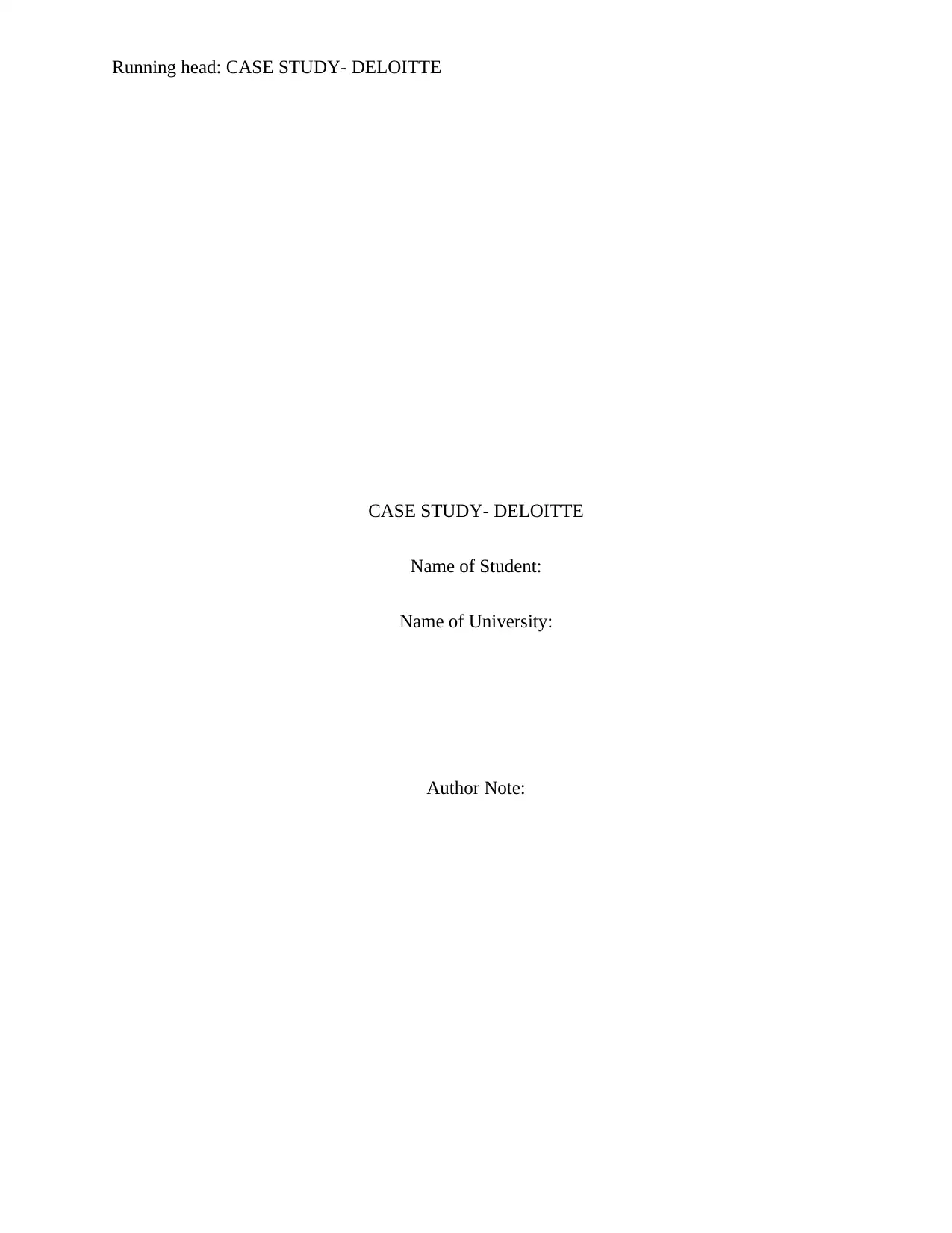
Running head: CASE STUDY- DELOITTE
CASE STUDY- DELOITTE
Name of Student:
Name of University:
Author Note:
CASE STUDY- DELOITTE
Name of Student:
Name of University:
Author Note:
Paraphrase This Document
Need a fresh take? Get an instant paraphrase of this document with our AI Paraphraser
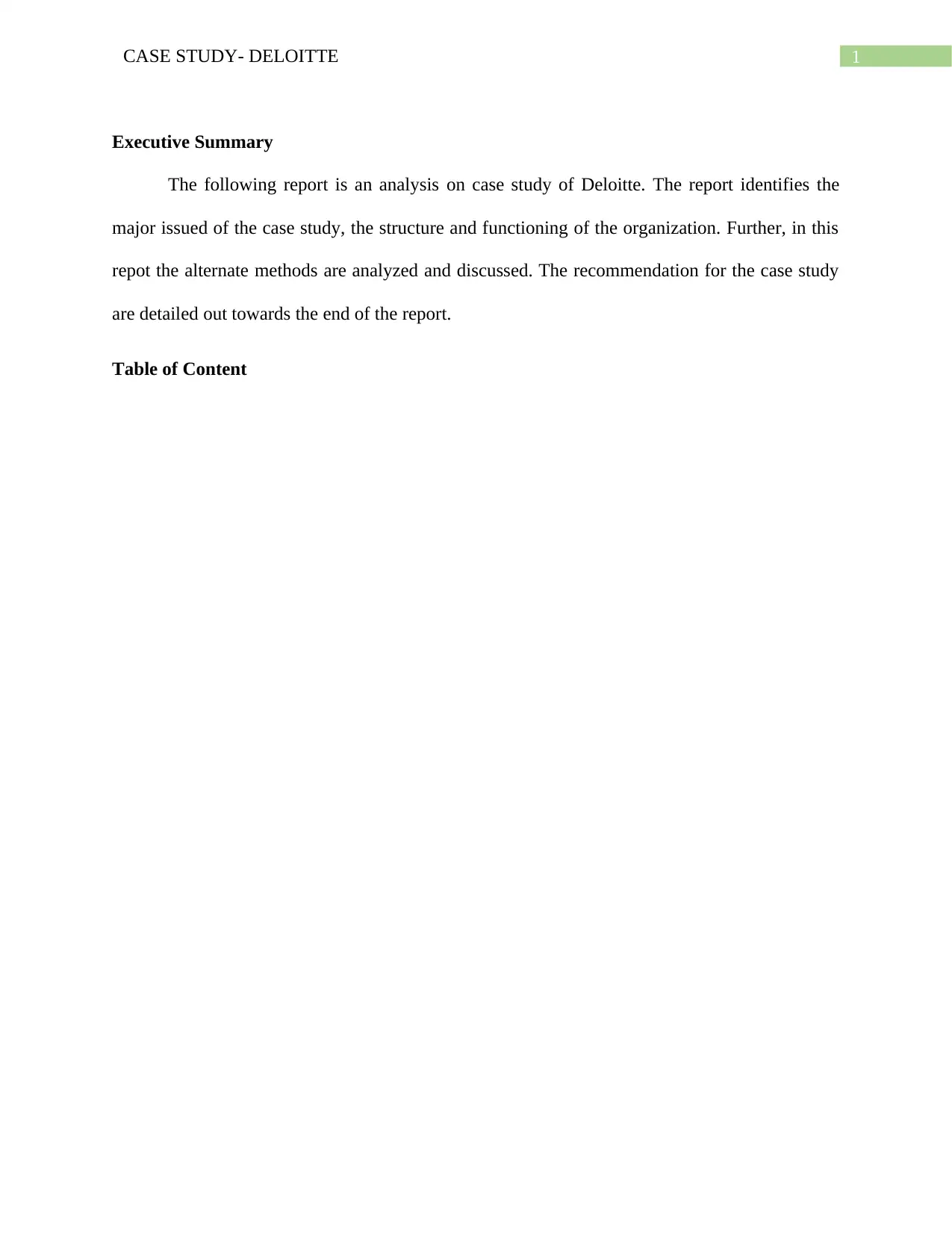
1CASE STUDY- DELOITTE
Executive Summary
The following report is an analysis on case study of Deloitte. The report identifies the
major issued of the case study, the structure and functioning of the organization. Further, in this
repot the alternate methods are analyzed and discussed. The recommendation for the case study
are detailed out towards the end of the report.
Table of Content
Executive Summary
The following report is an analysis on case study of Deloitte. The report identifies the
major issued of the case study, the structure and functioning of the organization. Further, in this
repot the alternate methods are analyzed and discussed. The recommendation for the case study
are detailed out towards the end of the report.
Table of Content
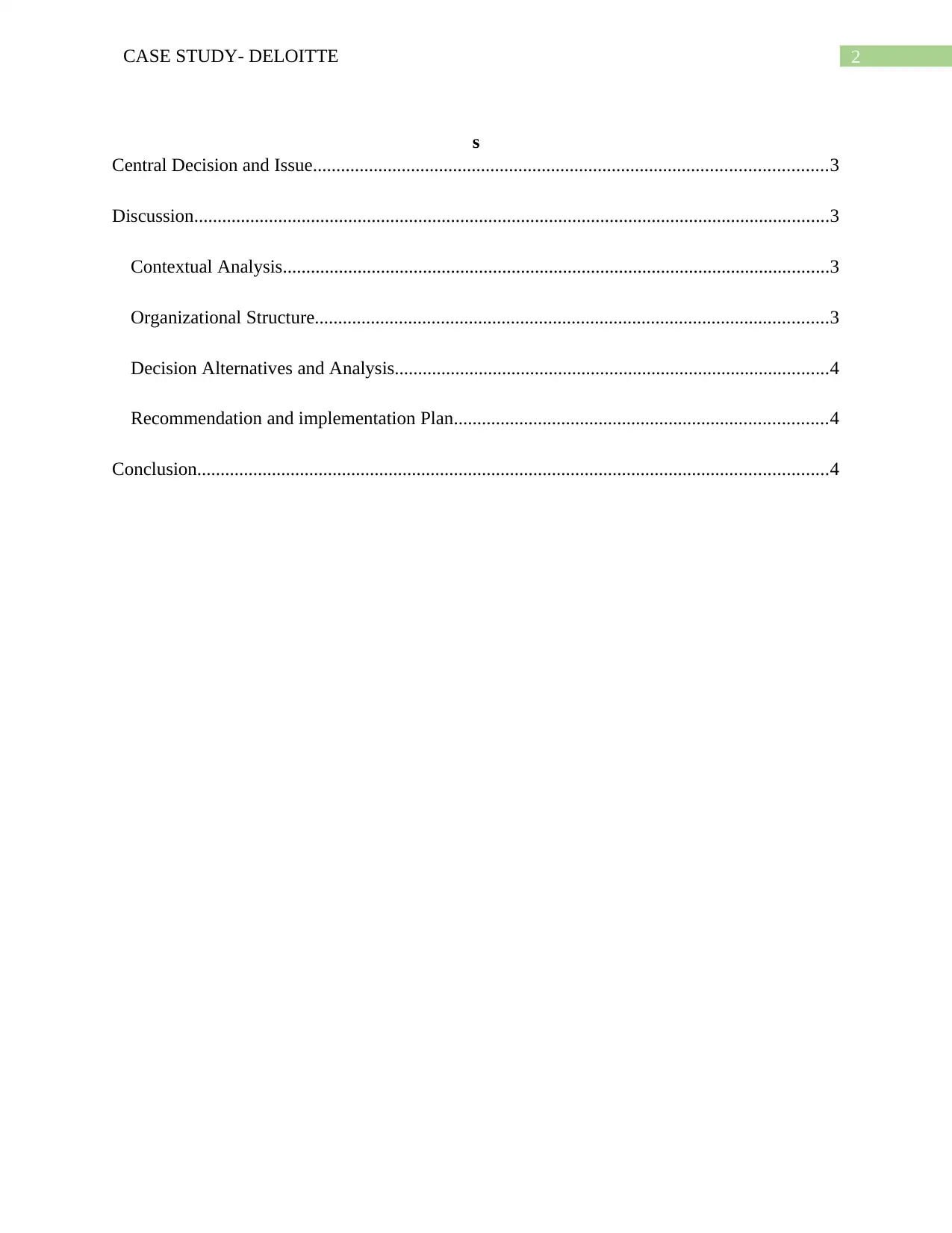
2CASE STUDY- DELOITTE
s
Central Decision and Issue..............................................................................................................3
Discussion........................................................................................................................................3
Contextual Analysis.....................................................................................................................3
Organizational Structure..............................................................................................................3
Decision Alternatives and Analysis.............................................................................................4
Recommendation and implementation Plan................................................................................4
Conclusion.......................................................................................................................................4
s
Central Decision and Issue..............................................................................................................3
Discussion........................................................................................................................................3
Contextual Analysis.....................................................................................................................3
Organizational Structure..............................................................................................................3
Decision Alternatives and Analysis.............................................................................................4
Recommendation and implementation Plan................................................................................4
Conclusion.......................................................................................................................................4
⊘ This is a preview!⊘
Do you want full access?
Subscribe today to unlock all pages.

Trusted by 1+ million students worldwide
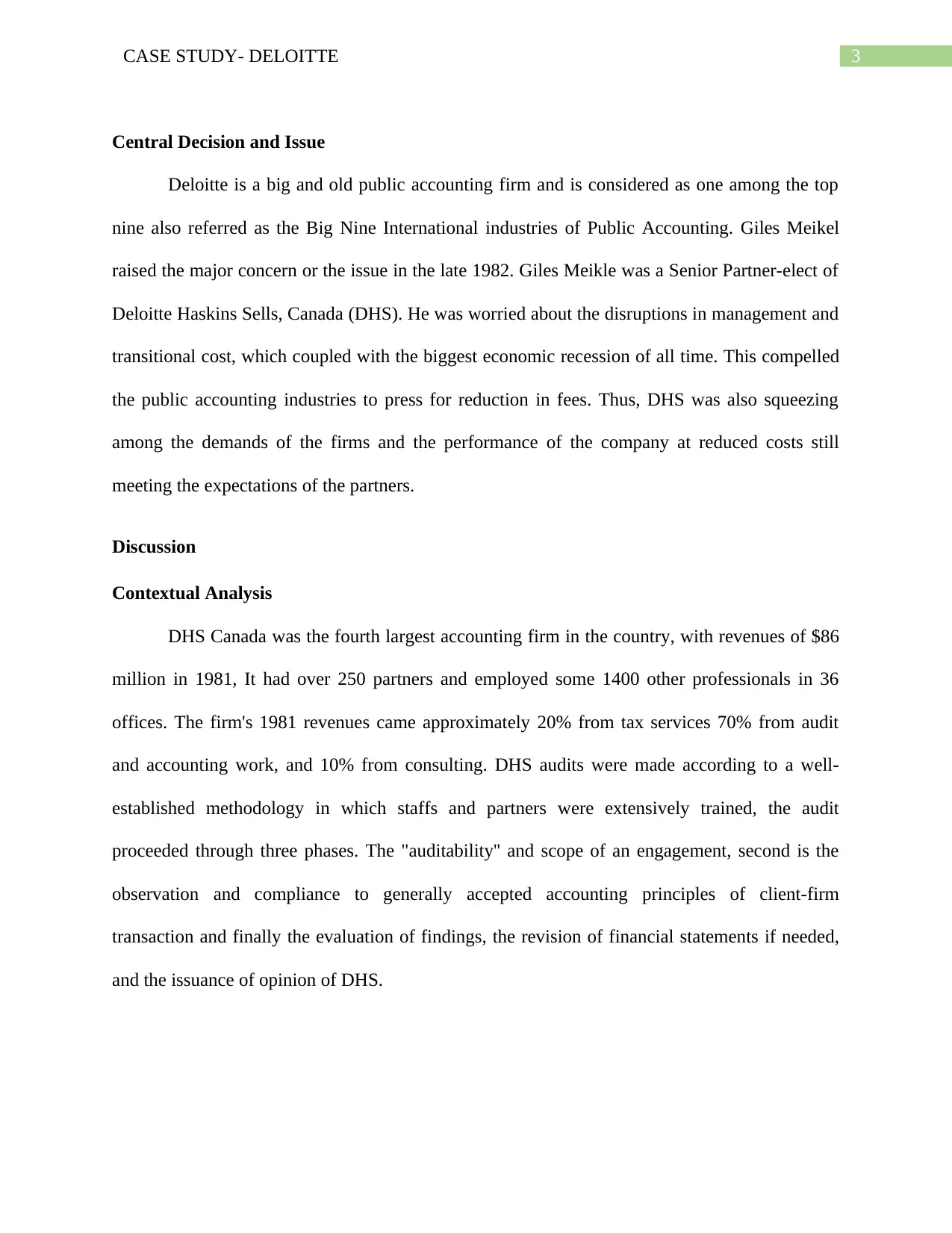
3CASE STUDY- DELOITTE
Central Decision and Issue
Deloitte is a big and old public accounting firm and is considered as one among the top
nine also referred as the Big Nine International industries of Public Accounting. Giles Meikel
raised the major concern or the issue in the late 1982. Giles Meikle was a Senior Partner-elect of
Deloitte Haskins Sells, Canada (DHS). He was worried about the disruptions in management and
transitional cost, which coupled with the biggest economic recession of all time. This compelled
the public accounting industries to press for reduction in fees. Thus, DHS was also squeezing
among the demands of the firms and the performance of the company at reduced costs still
meeting the expectations of the partners.
Discussion
Contextual Analysis
DHS Canada was the fourth largest accounting firm in the country, with revenues of $86
million in 1981, It had over 250 partners and employed some 1400 other professionals in 36
offices. The firm's 1981 revenues came approximately 20% from tax services 70% from audit
and accounting work, and 10% from consulting. DHS audits were made according to a well-
established methodology in which staffs and partners were extensively trained, the audit
proceeded through three phases. The "auditability'' and scope of an engagement, second is the
observation and compliance to generally accepted accounting principles of client-firm
transaction and finally the evaluation of findings, the revision of financial statements if needed,
and the issuance of opinion of DHS.
Central Decision and Issue
Deloitte is a big and old public accounting firm and is considered as one among the top
nine also referred as the Big Nine International industries of Public Accounting. Giles Meikel
raised the major concern or the issue in the late 1982. Giles Meikle was a Senior Partner-elect of
Deloitte Haskins Sells, Canada (DHS). He was worried about the disruptions in management and
transitional cost, which coupled with the biggest economic recession of all time. This compelled
the public accounting industries to press for reduction in fees. Thus, DHS was also squeezing
among the demands of the firms and the performance of the company at reduced costs still
meeting the expectations of the partners.
Discussion
Contextual Analysis
DHS Canada was the fourth largest accounting firm in the country, with revenues of $86
million in 1981, It had over 250 partners and employed some 1400 other professionals in 36
offices. The firm's 1981 revenues came approximately 20% from tax services 70% from audit
and accounting work, and 10% from consulting. DHS audits were made according to a well-
established methodology in which staffs and partners were extensively trained, the audit
proceeded through three phases. The "auditability'' and scope of an engagement, second is the
observation and compliance to generally accepted accounting principles of client-firm
transaction and finally the evaluation of findings, the revision of financial statements if needed,
and the issuance of opinion of DHS.
Paraphrase This Document
Need a fresh take? Get an instant paraphrase of this document with our AI Paraphraser
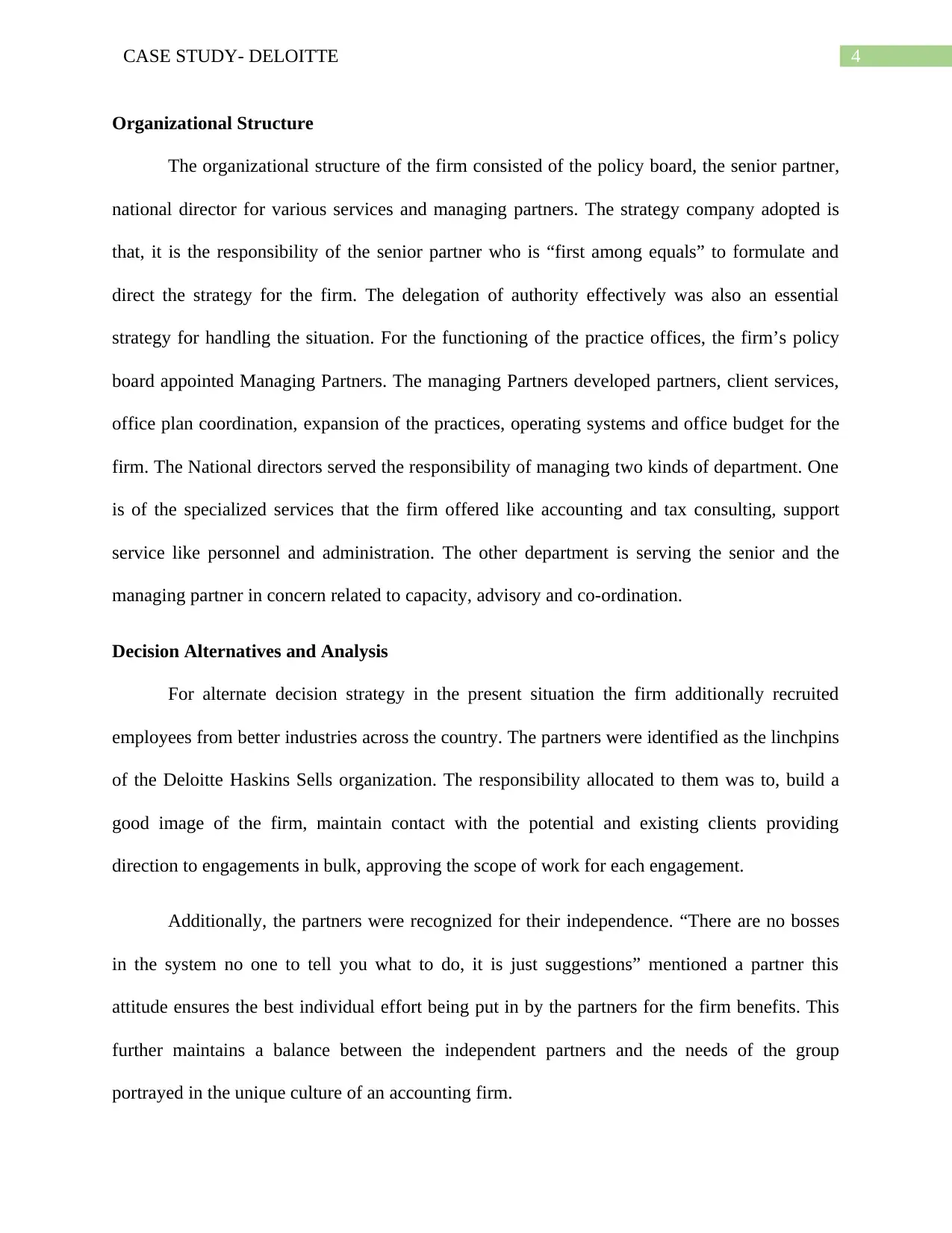
4CASE STUDY- DELOITTE
Organizational Structure
The organizational structure of the firm consisted of the policy board, the senior partner,
national director for various services and managing partners. The strategy company adopted is
that, it is the responsibility of the senior partner who is “first among equals” to formulate and
direct the strategy for the firm. The delegation of authority effectively was also an essential
strategy for handling the situation. For the functioning of the practice offices, the firm’s policy
board appointed Managing Partners. The managing Partners developed partners, client services,
office plan coordination, expansion of the practices, operating systems and office budget for the
firm. The National directors served the responsibility of managing two kinds of department. One
is of the specialized services that the firm offered like accounting and tax consulting, support
service like personnel and administration. The other department is serving the senior and the
managing partner in concern related to capacity, advisory and co-ordination.
Decision Alternatives and Analysis
For alternate decision strategy in the present situation the firm additionally recruited
employees from better industries across the country. The partners were identified as the linchpins
of the Deloitte Haskins Sells organization. The responsibility allocated to them was to, build a
good image of the firm, maintain contact with the potential and existing clients providing
direction to engagements in bulk, approving the scope of work for each engagement.
Additionally, the partners were recognized for their independence. “There are no bosses
in the system no one to tell you what to do, it is just suggestions” mentioned a partner this
attitude ensures the best individual effort being put in by the partners for the firm benefits. This
further maintains a balance between the independent partners and the needs of the group
portrayed in the unique culture of an accounting firm.
Organizational Structure
The organizational structure of the firm consisted of the policy board, the senior partner,
national director for various services and managing partners. The strategy company adopted is
that, it is the responsibility of the senior partner who is “first among equals” to formulate and
direct the strategy for the firm. The delegation of authority effectively was also an essential
strategy for handling the situation. For the functioning of the practice offices, the firm’s policy
board appointed Managing Partners. The managing Partners developed partners, client services,
office plan coordination, expansion of the practices, operating systems and office budget for the
firm. The National directors served the responsibility of managing two kinds of department. One
is of the specialized services that the firm offered like accounting and tax consulting, support
service like personnel and administration. The other department is serving the senior and the
managing partner in concern related to capacity, advisory and co-ordination.
Decision Alternatives and Analysis
For alternate decision strategy in the present situation the firm additionally recruited
employees from better industries across the country. The partners were identified as the linchpins
of the Deloitte Haskins Sells organization. The responsibility allocated to them was to, build a
good image of the firm, maintain contact with the potential and existing clients providing
direction to engagements in bulk, approving the scope of work for each engagement.
Additionally, the partners were recognized for their independence. “There are no bosses
in the system no one to tell you what to do, it is just suggestions” mentioned a partner this
attitude ensures the best individual effort being put in by the partners for the firm benefits. This
further maintains a balance between the independent partners and the needs of the group
portrayed in the unique culture of an accounting firm.
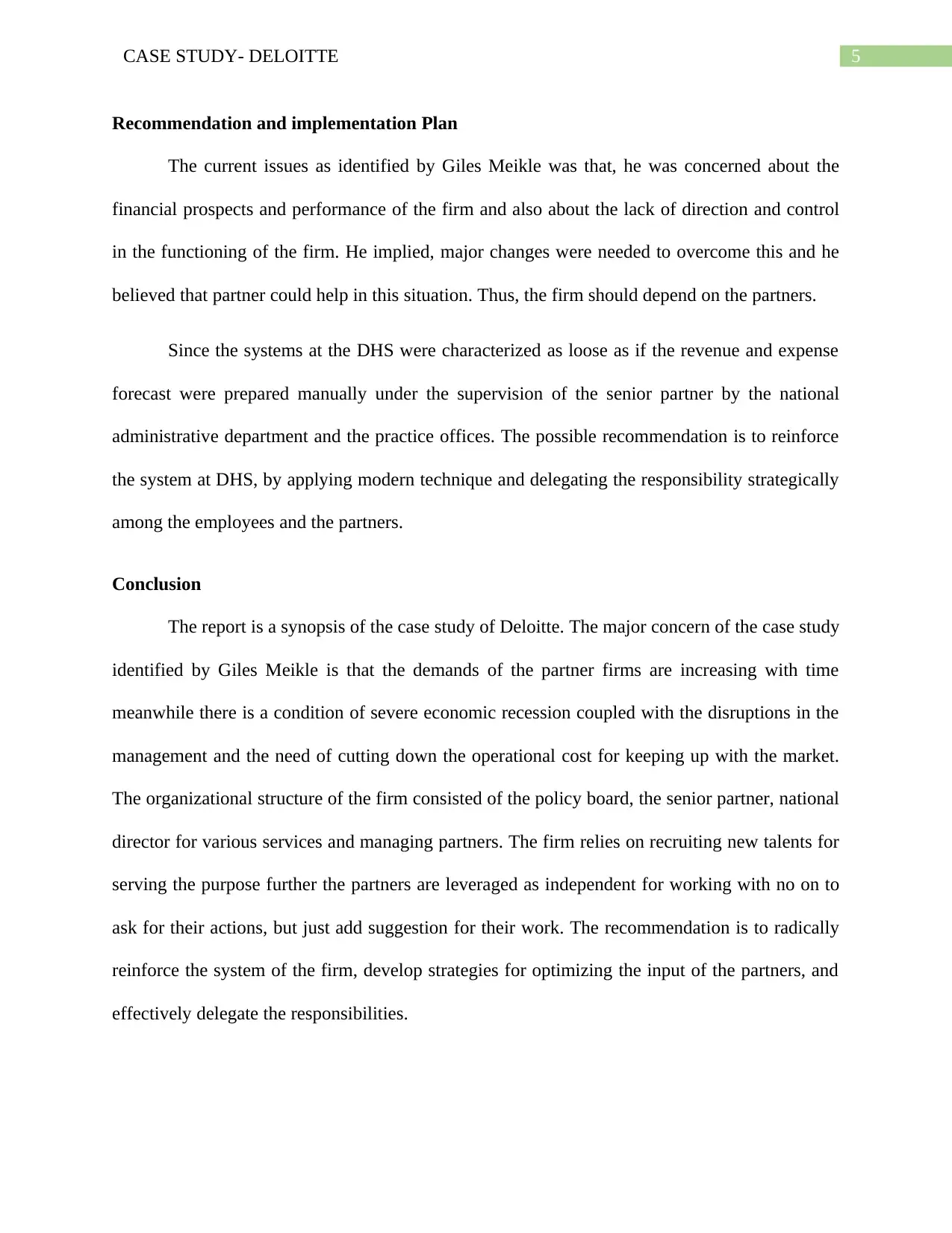
5CASE STUDY- DELOITTE
Recommendation and implementation Plan
The current issues as identified by Giles Meikle was that, he was concerned about the
financial prospects and performance of the firm and also about the lack of direction and control
in the functioning of the firm. He implied, major changes were needed to overcome this and he
believed that partner could help in this situation. Thus, the firm should depend on the partners.
Since the systems at the DHS were characterized as loose as if the revenue and expense
forecast were prepared manually under the supervision of the senior partner by the national
administrative department and the practice offices. The possible recommendation is to reinforce
the system at DHS, by applying modern technique and delegating the responsibility strategically
among the employees and the partners.
Conclusion
The report is a synopsis of the case study of Deloitte. The major concern of the case study
identified by Giles Meikle is that the demands of the partner firms are increasing with time
meanwhile there is a condition of severe economic recession coupled with the disruptions in the
management and the need of cutting down the operational cost for keeping up with the market.
The organizational structure of the firm consisted of the policy board, the senior partner, national
director for various services and managing partners. The firm relies on recruiting new talents for
serving the purpose further the partners are leveraged as independent for working with no on to
ask for their actions, but just add suggestion for their work. The recommendation is to radically
reinforce the system of the firm, develop strategies for optimizing the input of the partners, and
effectively delegate the responsibilities.
Recommendation and implementation Plan
The current issues as identified by Giles Meikle was that, he was concerned about the
financial prospects and performance of the firm and also about the lack of direction and control
in the functioning of the firm. He implied, major changes were needed to overcome this and he
believed that partner could help in this situation. Thus, the firm should depend on the partners.
Since the systems at the DHS were characterized as loose as if the revenue and expense
forecast were prepared manually under the supervision of the senior partner by the national
administrative department and the practice offices. The possible recommendation is to reinforce
the system at DHS, by applying modern technique and delegating the responsibility strategically
among the employees and the partners.
Conclusion
The report is a synopsis of the case study of Deloitte. The major concern of the case study
identified by Giles Meikle is that the demands of the partner firms are increasing with time
meanwhile there is a condition of severe economic recession coupled with the disruptions in the
management and the need of cutting down the operational cost for keeping up with the market.
The organizational structure of the firm consisted of the policy board, the senior partner, national
director for various services and managing partners. The firm relies on recruiting new talents for
serving the purpose further the partners are leveraged as independent for working with no on to
ask for their actions, but just add suggestion for their work. The recommendation is to radically
reinforce the system of the firm, develop strategies for optimizing the input of the partners, and
effectively delegate the responsibilities.
⊘ This is a preview!⊘
Do you want full access?
Subscribe today to unlock all pages.

Trusted by 1+ million students worldwide

6CASE STUDY- DELOITTE
1 out of 7
Related Documents
Your All-in-One AI-Powered Toolkit for Academic Success.
+13062052269
info@desklib.com
Available 24*7 on WhatsApp / Email
![[object Object]](/_next/static/media/star-bottom.7253800d.svg)
Unlock your academic potential
Copyright © 2020–2025 A2Z Services. All Rights Reserved. Developed and managed by ZUCOL.





